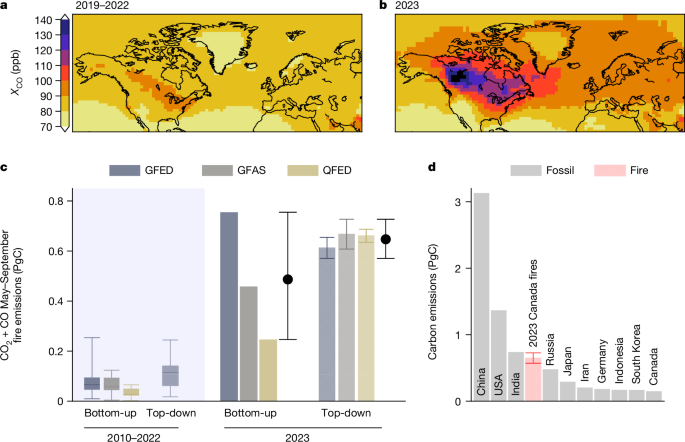Massive Carbon Emissions from Unprecedented 2023 Canadian Wildfires Raise Concerns about Forest Sustainability
Основні поняття
The 2023 Canadian forest fires have released massive amounts of carbon emissions, comparable to the annual fossil fuel emissions of large nations, driven by extreme hot-dry weather conditions that are likely to become more common in the future, posing a threat to the long-term viability of Canadian forests as a carbon sink.
Анотація
The content discusses the significant carbon emissions from the 2023 Canadian forest fires, which have been extreme in scale and intensity. Using inverse modeling of satellite carbon monoxide observations, the researchers found that the magnitude of the carbon emissions is 647 TgC (570–727 TgC), comparable to the annual fossil fuel emissions of large nations like India, China, and the USA.
The researchers attribute the widespread fire spread to the hot-dry weather conditions in 2023, which was the warmest and driest year since at least 1980. Climate projections indicate that these temperature conditions are likely to be typical during the 2050s, even under a moderate climate mitigation scenario. Such conditions are likely to drive increased fire activity and suppress carbon uptake by Canadian forests, adding to concerns about the long-term durability of these forests as a carbon sink.
Переписати за допомогою ШІ
Перекласти джерело
Іншою мовою
Згенерувати інтелект-карту
із вихідного контенту
Перейти до джерела
www.nature.com
Carbon emissions from the 2023 Canadian wildfires - Nature
Статистика
The 2023 Canadian forest fires have burned more than seven times the average annual area compared to the previous four decades.
The magnitude of the carbon emissions from the 2023 Canadian forest fires is 647 TgC (570–727 TgC).
The year 2023 was the warmest and driest year in Canada since at least 1980.
Climate projections indicate that the temperature conditions observed in 2023 are likely to be typical during the 2050s, even under a moderate climate mitigation scenario.
Цитати
"The 2023 Canadian forest fires have been extreme in scale and intensity with more than seven times the average annual area burned compared to the previous four decades."
"We find that the magnitude of the carbon emissions is 647 TgC (570–727 TgC), comparable to the annual fossil fuel emissions of large nations, with only India, China and the USA releasing more carbon per year."
"Climate projections indicate that these temperatures are likely to be typical during the 2050s, even under a moderate climate mitigation scenario (shared socioeconomic pathway, SSP 2–4.5)."
Глибші Запити
How can Canada and other affected regions develop more effective strategies to mitigate and adapt to the increasing threat of wildfires driven by climate change?
To address the escalating threat of wildfires exacerbated by climate change, Canada and other affected regions can implement a multi-faceted approach. Firstly, investing in advanced early warning systems and fire detection technologies can help in the rapid identification and containment of wildfires before they escalate. Additionally, promoting sustainable forest management practices, such as prescribed burns and fuel reduction measures, can reduce the buildup of flammable materials and mitigate the intensity of wildfires. Collaborative efforts between government agencies, local communities, and indigenous groups are crucial to develop comprehensive wildfire response plans that prioritize both prevention and preparedness. Furthermore, enhancing public awareness through education campaigns on fire safety and the importance of ecosystem resilience can foster a culture of wildfire prevention and conservation. By integrating these strategies with climate change adaptation measures, such as land-use planning and infrastructure resilience, Canada and other regions can better mitigate the increasing threat of wildfires driven by climate change.
What are the potential long-term ecological and economic consequences of the sustained loss of Canadian forests as a carbon sink due to increased fire activity?
The sustained loss of Canadian forests as a carbon sink due to increased fire activity can have profound long-term ecological and economic consequences. Ecologically, the degradation of forests diminishes biodiversity, disrupts ecosystem services, and alters natural habitats, leading to cascading effects on wildlife populations and ecological balance. The loss of carbon sequestration capacity in forests contributes to elevated atmospheric carbon dioxide levels, exacerbating climate change and further intensifying the cycle of wildfires. Economically, the decline of forests as a carbon sink can impact industries reliant on forest resources, such as timber, tourism, and agriculture, leading to economic instability and loss of livelihoods. Moreover, the costs associated with wildfire suppression, post-fire recovery, and ecosystem restoration can strain government budgets and hinder sustainable development efforts. Overall, the sustained loss of Canadian forests as a carbon sink not only threatens the ecological integrity of the region but also poses significant economic challenges that require proactive mitigation and adaptation strategies.
What innovative technologies or approaches could be explored to enhance the resilience and carbon sequestration capacity of Canadian forests in the face of these climate-driven challenges?
Innovative technologies and approaches can play a pivotal role in enhancing the resilience and carbon sequestration capacity of Canadian forests amidst climate-driven challenges. One promising avenue is the utilization of remote sensing technologies, such as drones and satellite imagery, for early detection of wildfire risks, monitoring forest health, and assessing carbon stocks. Implementing artificial intelligence and machine learning algorithms can improve predictive modeling of fire behavior and ecosystem dynamics, enabling more targeted and effective forest management strategies. Furthermore, exploring biochar application techniques, which involve converting biomass into a stable form of carbon, can enhance soil fertility, sequester carbon, and mitigate the impacts of wildfires on forest ecosystems. Embracing agroforestry practices, such as integrating tree planting with agricultural activities, can diversify land use, enhance ecosystem resilience, and promote sustainable carbon sequestration. By embracing these innovative technologies and approaches, Canada can bolster the resilience of its forests and strengthen their capacity to sequester carbon in the face of escalating climate-driven challenges.

